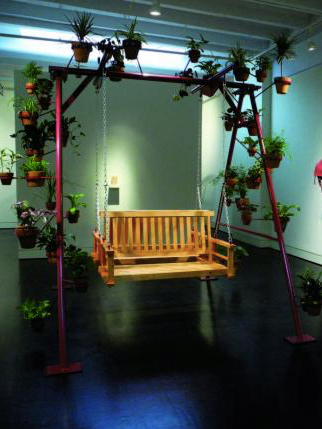
The D.C.-based Workingman Collective was founded in 2005 and centers on the wide-ranging activities of members Janis Goodman, Tom Ashcraft and Peter Winant. In their words, the collective privileges strategies of “process, invention, chance and the public,” and they aim to create scenarios that encourage collaborative—and ideally constructive—effort. In the past their efforts have included neighborhood interventions around D.C., such as building a mobile community center and working with the National Zoo to create a series of urban birdhouses. “Prospects and Provisions,” their recent show at Hemphill, marked the collective’s first solo foray into a gallery setting.
The artworks on display (all 2011) are invitations. Swing is a two-sided, back-to-back porch swing adorned with plants, each chosen for specific air-cleansing properties and watered daily by a rotating crew of volunteers. The large wooden Table supports an overhead steel frame on which a model locomotive chugs in circles around an oval track. During the course of the exhibition, Swing and Table acted as meeting grounds for numerous gatherings, such as weekly lunches with collective artists, vocal workshops led by a local soprano and poetry readings. In addition, photographs, prints and an array of small objects relating to past and present Workingman projects were on view. These included an edition of seven newly fabricated backpacks, based on a vintage design found on eBay, that the artists hope a user will fill with “tools for the modern adventurer.”
There are inevitable growing pains when attempting to adapt any social/experiential idea to the object-based world of a commercial gallery. Contract manifests this particular type of awkwardness: here seven small notebooks were displayed on a ledge next to a text outlining the collective’s acquisitions protocol: “1) Collector fills in notebooks, 2) Collector shares the contents of the notebooks with Workingman Collective, 3) Workingman Collective and collector conceptualize the creation of a potential artwork.”
If one felt the collective’s intentions to be sarcastic (which I don’t), Contract could be read as a dig at collectors who pay professional artists to realize—and in turn legitimize—their own creative ambitions. However sincere its intentions, Contract’s impression is that of artists scrambling to bottle (and sell) the principle of collectivity itself. Stronger work emerges when the invitation to participate is examined rather than enacted, as in Champion, a video installation consisting of half a Ping-Pong table sprouting various potted plants and abutted by a 32-inch television monitor. The piece creates an unexpected sense of tension as the viewer, standing behind the table and facing the monitor, “plays” a bespectacled male competitor who lobs return shots on-screen.
For all its pluck and polish, “Prospects and Provisions” failed to emphasize any meaningful statement beyond that which is broadly invoked in the mission of the collective itself. Still, in a city where the word “bipartisan” increasingly masks an obdurate, self-righteous refusal to bargain, it’s hard not to give credit to any serious invitation to sit down at the table.